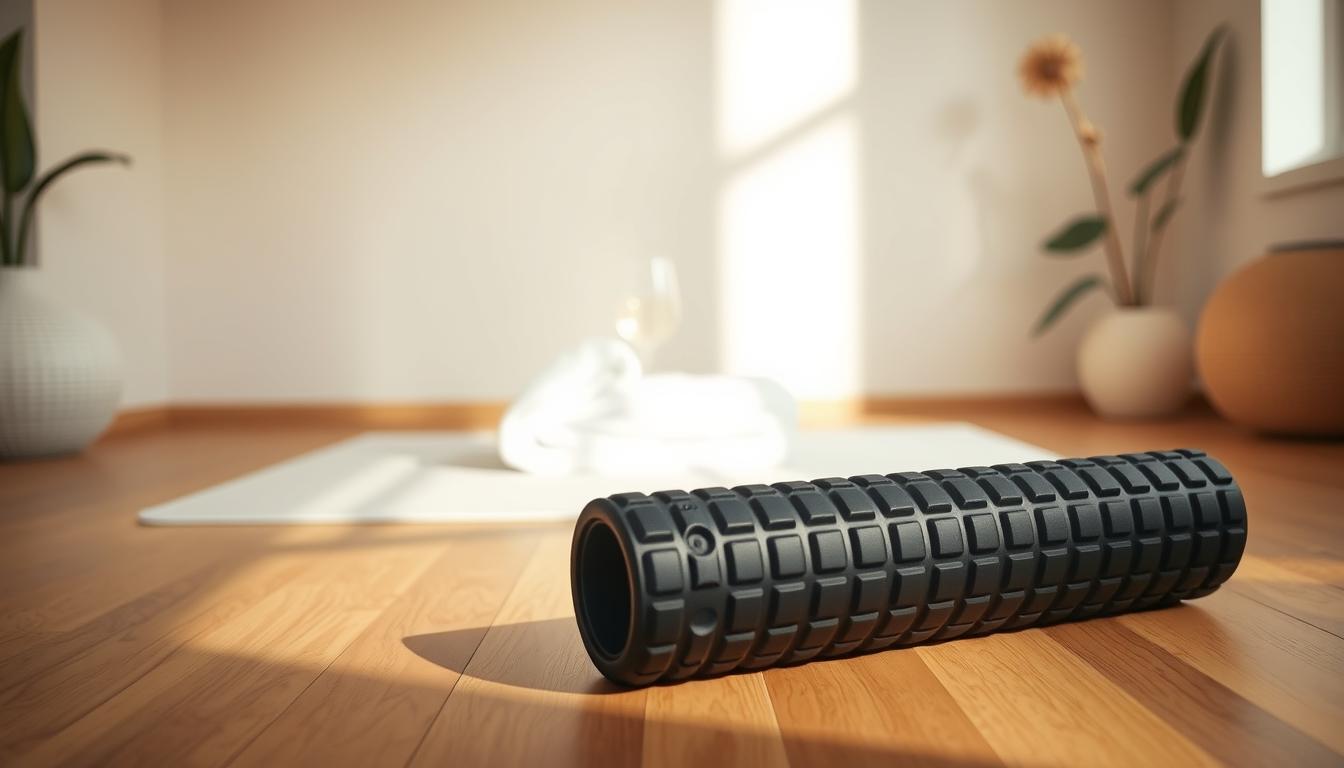Nowadays, many of us face neck pain from spending too much time at our desks. This article will show you how stretching can fight neck pain and make you feel better. By using special neck exercises and stretches after work, you can ease pain and stop new problems. These smart steps lead to less neck pain and a happier life.
Understanding Neck Pain and Its Causes
Neck pain can really change how we do daily things, often coming from different causes. Knowing what causes the pain helps us avoid and treat it. Usual causes are muscle strain, not sitting right, and bad desk setups. By understanding these, we can work on better neck health.
Common Causes of Neck Pain
Muscle strains often lead to neck pain, usually from using them too much or moving suddenly. Poor posture, especially when sitting for a long time, makes it worse. Simple things like looking down at our phones or slumping at our computers are bad for our necks. If we don’t sit right, our necks can get stiff and cause ongoing problems.
Impact of Poor Posture on Neck Health
Bad posture, like slouching or sticking your head out, puts too much pressure on the neck. This makes muscles tired and increases pain. Keeping the neck in one position for too long, especially with bad desk setups, makes it prone to tension and stiffness. Not fixing bad posture can cause short-term pain and long-term neck issues.
Signs You Need a Stretching Routine
It’s important to know when you need to start stretching for neck health. Certain signs of neck pain tell you it’s time to add stretching to your day. Knowing these signs helps you figure out the right time to start doing stretches to ease the pain.
Identifying Neck Pain Symptoms
Common neck pain symptoms include:
- Stiffness in the neck that limits mobility
- Soreness that persists through daily activities
- Sharp or shooting pain radiating into the shoulders or arms
- Tension headaches associated with muscle tightness
Pay attention to these symptoms to know if stretching could help. Stretching is key for easing tightness and boosting flexibility, which helps with neck pain.
When to Consult a Medical Professional
If neck pain doesn’t improve with stretching, it’s time to see a doctor. You should get help if you have:
- Severe headaches that accompany neck pain
- Numbness or tingling sensations in the arms or hands
- Loss of strength or coordination in the upper body
Notice these serious signs to avoid more issues. Taking care of your health means dealing with problems early on.
Benefits of Stretching for Neck Pain Relief
Adding stretching to your daily activities helps manage neck pain. It’s especially helpful if your pain comes from everyday movements or staying in one position for too long. Knowing how stretching can ease your pain is a big plus.
Enhanced Flexibility and Mobility
Stretching your neck regularly makes it more flexible. This flexibility helps you move easier, which is great for repetitive tasks. If you get stiff from sitting all day, these stretches are for you.
Reduction in Muscle Tension and Pain
Stretching eases muscle tightness by increasing blood flow. Doing it often can really help loosen your neck muscles. Studies show that regular stretching is key to managing neck pain. This makes everyday life more comfortable.
Stretching Routine for Neck Pain After Long Work Hours
If you work long hours, a good neck stretching routine can help ease your pain. You should include neck slides, turns, and shoulder lifts in your after-work stretch time. These moves are simple and can be done right at your desk or at home, making them easy for everyone to do.
Overview of the Stretching Routine
This routine aims to improve flexibility and reduce pain with easy moves. By adding these stretches to your daily routine, you can fight off the stiffness. This often comes from sitting too much or not sitting right.
Frequency and Duration Recommendations
To get the best results, stretch after work two or three times a week. Hold each stretch for 15-30 seconds to get the most out of it. If your neck still hurts a lot, stretching every day can help you heal faster and feel less stiff as time goes on.
Essential Neck Stretches to Incorporate
Adding certain neck stretches to your daily routine can greatly improve your flexibility. They also ease discomfort. These stretches focus on improving movement and easing tension in your neck and shoulders. By using the neck glide technique, doing neck rotations, and performing shoulder shrugs, your neck’s health can get better.
Neck Glide Technique
This stretch is about slowly moving your chin forward while keeping the neck straight. It helps to lessen tightness in the neck muscles. You should stay in this position for five seconds and do it up to 10 times. Doing this stretch is simple but really helpful for your neck.
Neck Rotation for Increased Range of Motion
To do this stretch, gently rotate your head from one side to the other. This reduces tension and improves your neck’s flexibility. Stay on each side for 10 seconds and repeat several times. This helps your neck move better and become more flexible.
Effective Shoulder Shrugs
Shoulder shrugs are key for making your upper body feel less stressed. Lift your shoulders up toward your ears, then drop them back down. Doing this a few times can reduce tightness. It helps make your shoulders and neck more relaxed.
Deep Stretching Techniques for Greater Relief
Adding deep neck stretches to your routine can really help with neck stiffness. The towel pull and forward flexion are two great methods. They work on different parts of the neck for all-around comfort and relief.
Towel Pull for Neck Support
For the towel pull, you’ll need a rolled towel to create a bit of resistance. Put the towel behind your neck and grab each end. Slowly lift your head while pulling on the towel lightly. This helps your neck stay straight and supported, making the stretch more effective.
Forward Flexion to Alleviate Stiffness
Bending your head down to your chest is a simple way to do forward flexion. It stretches the back neck muscles, easing stiffness. Make sure to breathe deeply while stretching. This increases blood flow and makes the stretch feel even better.
Quick Stretching Exercises You Can Do at Work
Adding quick neck relief exercises to your workday can greatly lessen tension. Making simple changes and doing easy stretches at work keeps your energy up and boosts productivity. Sitting in a neutral position lessens neck and shoulder strain.
Incorporating Neutral Positioning
Maintaining a neutral posture is key to avoid too much neck strain. Make sure your monitor is at eye level to keep your neck straight. Keep your shoulders relaxed and your elbows close while typing. These small changes make your workspace more comfortable and improve your posture.
Easy Desk Stretches to Use
Making time for stretches at your desk can quickly ease neck tension. Try these easy stretches:
- Neck tilts: Gently tilt your head towards each shoulder to stretch the sides of your neck.
- Shoulder rolls: Lift your shoulders up to your ears, then roll them back and down to ease tension.
- Chin tucks: Pull your chin to your chest and hold for a few seconds to stretch your neck’s back.
Establishing a Routine: Best Practices for Effective Stretching
Starting a good stretching routine is about more than just the stretches themselves. It’s about being regular and paying attention to how your body feels. By sticking to best practices, you can become more in tune with your body. This makes stretching a key part of your daily life.
Setting Reminders for Stretching
Having a specific schedule for stretching helps you remember to do it. Here are some ways to remind yourself:
- Use alarms on your phone or computer to signal stretching times.
- Set calendar alerts to remind you to stretch regularly.
- Keep visual reminders around your work area to prompt you to stretch.
Listening to Your Body While Stretching
It’s key to listen to what your body tells you when stretching. Feeling a bit of tension is okay, but pain is a warning sign. Below are tips to help you pay attention to your body while stretching:
- Notice how each stretch feels and make adjustments if needed.
- Avoid stretches that cause pain or too much tension.
- Check in with how comfortable you feel to better your stretching over time.
Supplementing Stretches with Other Neck Care Techniques
To make your neck stretches better, add other care techniques. Using heat therapy and ice therapy helps a lot and has different purposes. These can enhance your stretching exercises. It’s also key to have an ergonomic workplace to keep your neck right during the day.
Heat and Ice Treatment for Pain Relief
Heat and ice together can greatly ease neck pain. Heat therapy boosts blood flow and relaxes muscles, great after work. It loosens tight spots. On the other hand, ice therapy lessens swelling and numbs pain. Try using both heat and ice to get the most out of it in your care routine.
Importance of Ergonomics at Your Workstation
Having an ergonomic workstation is key to stopping neck pain. The right chair height, desk setup, and where your monitor is placed play a big role. Make sure your monitor is at eye level and your chair supports your lower back. Small changes like these improve your posture and reduce neck strain, important for staying well.

Conclusion
Making stretching a daily habit can really help with neck pain, especially for those who sit at a desk all day. Focusing on tips for neck health lets people actively reduce their discomfort. Stretching makes you more flexible and helps stop chronic pain before it starts.
But it’s not just about stretching. You also need to make sure your workspace is set up right for your body. This can ease the strain on your neck and shoulders. If your neck pain won’t go away, it’s important to get advice from a doctor.
So, taking care of your neck with stretches and a good workspace setup is important. These steps help you work more comfortably. They can lead to a future without neck pain.



